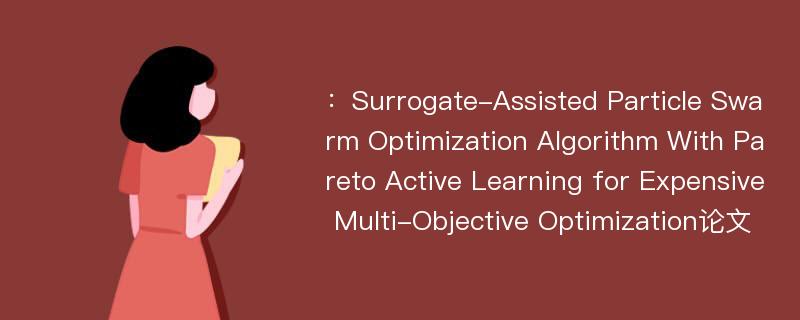
本文主要研究内容
作者(2019)在《Surrogate-Assisted Particle Swarm Optimization Algorithm With Pareto Active Learning for Expensive Multi-Objective Optimization》一文中研究指出:For multi-objective optimization problems, particle swarm optimization(PSO) algorithm generally needs a large number of fitness evaluations to obtain the Pareto optimal solutions. However, it will become substantially time-consuming when handling computationally expensive fitness functions. In order to save the computational cost, a surrogate-assisted PSO with Pareto active learning is proposed. In real physical space(the objective functions are computationally expensive), PSO is used as an optimizer, and its optimization results are used to construct the surrogate models. In virtual space, objective functions are replaced by the cheaper surrogate models, PSO is viewed as a sampler to produce the candidate solutions. To enhance the quality of candidate solutions, a hybrid mutation sampling method based on the simulated evolution is proposed, which combines the advantage of fast convergence of PSO and implements mutation to increase diversity. Furthermore, ε-Pareto active learning(ε-PAL)method is employed to pre-select candidate solutions to guide PSO in the real physical space. However, little work has considered the method of determining parameter ε. Therefore, a greedy search method is presented to determine the value ofεwhere the number of active sampling is employed as the evaluation criteria of classification cost. Experimental studies involving application on a number of benchmark test problems and parameter determination for multi-input multi-output least squares support vector machines(MLSSVM) are given, in which the results demonstrate promising performance of the proposed algorithm compared with other representative multi-objective particle swarm optimization(MOPSO) algorithms.
Abstract
For multi-objective optimization problems, particle swarm optimization(PSO) algorithm generally needs a large number of fitness evaluations to obtain the Pareto optimal solutions. However, it will become substantially time-consuming when handling computationally expensive fitness functions. In order to save the computational cost, a surrogate-assisted PSO with Pareto active learning is proposed. In real physical space(the objective functions are computationally expensive), PSO is used as an optimizer, and its optimization results are used to construct the surrogate models. In virtual space, objective functions are replaced by the cheaper surrogate models, PSO is viewed as a sampler to produce the candidate solutions. To enhance the quality of candidate solutions, a hybrid mutation sampling method based on the simulated evolution is proposed, which combines the advantage of fast convergence of PSO and implements mutation to increase diversity. Furthermore, ε-Pareto active learning(ε-PAL)method is employed to pre-select candidate solutions to guide PSO in the real physical space. However, little work has considered the method of determining parameter ε. Therefore, a greedy search method is presented to determine the value ofεwhere the number of active sampling is employed as the evaluation criteria of classification cost. Experimental studies involving application on a number of benchmark test problems and parameter determination for multi-input multi-output least squares support vector machines(MLSSVM) are given, in which the results demonstrate promising performance of the proposed algorithm compared with other representative multi-objective particle swarm optimization(MOPSO) algorithms.
论文参考文献
论文详细介绍
论文作者分别是来自IEEE/CAA Journal of Automatica Sinica的,发表于刊物IEEE/CAA Journal of Automatica Sinica2019年03期论文,是一篇关于,IEEE/CAA Journal of Automatica Sinica2019年03期论文的文章。本文可供学术参考使用,各位学者可以免费参考阅读下载,文章观点不代表本站观点,资料来自IEEE/CAA Journal of Automatica Sinica2019年03期论文网站,若本站收录的文献无意侵犯了您的著作版权,请联系我们删除。
